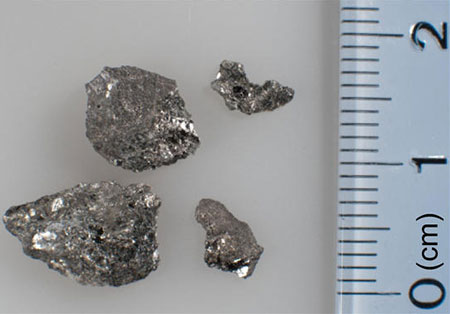| Posted: Mar 11, 2013 | |
Researchers discover a naturally occurring topological insulator(Nanowerk Spotlight) Strange new materials experimentally identified just a few years ago are now driving research in condensed-matter physics around the world. First theorized and then discovered by researchers at the Berkeley Lab and their colleagues in other institutions, these "strong 3-D topological insulators" — TIs for short – are seemingly mundane semiconductors with startling properties. For starters, picture a good insulator on the inside that's a good conductor on its surface – something like a copper-coated bowling ball (read more: "Beyond the high-speed hard drive: Topological insulators open a path to room-temperature spintronics"). |
|
| Topological insulators offer unique opportunities to control electric currents and magnetism, and are promising materials for future spintronic applications or could provide access to novel, fascinating physical phenomena such as Majorana fermions ("Unconventional Superconductivity on a Topological Insulator") or magnetic monopoles ("Inducing a Magnetic Monopole with Topological Surface States"). This is due to their intriguing charge transport channels on their surface, in which the electron spin is coupled to its momentum. | |
| One possible application enabled in this manner could be spin filters. Spin is a quantum-mechanical property of electrons that can take either of two values – somewhat akin to magnets that can orient their poles in either of two opposed directions. Conventional electronics takes no account of electron spin; but it has been suggested that a spin-dependent form of electronics, called spintronics, could provide new and powerful ways to process information. A spin filter would let a current pass only if the electrons have the correct spin. | |
| While so far, only synthetic TIs had been experimentally identified, in the February 26, 2013 online edition of Nano Letters ("A Natural Topological Insulator"), researchers in Germany report the discovery of a natural occurring topological insulator: the mineral Kawazulite. | |
 |
|
| Optical micrograph of the investigated Kawazulite specimens with a size between 3 and 10 mm. (Reprinted with permission from American Chemical Society) | |
| "Our exploration into natural topological insulators has been motivated by the major problem in topological insulators, namely their sizeable defect concentration, which renders them into highly doped, electrically conductive semiconductors," Pascal Gehring, a scientist in the Quantum Materials & Nanoelectronics group at the Max-Planck-Institut für Festkörperforschung in Stuttgart, explains to Nanowerk. "This complicates the detection of signatures related to their surface states. We had envisioned that due to the geological age of minerals, their crystal structure may have reached close-to-perfection, thus minimizing interference from the doped bulk." | |
| When exploring Kawazulite, found in a Czech gold mine and processed into nanoflakes, the team found that it is a natural topological insulator. | |
| "We hypothesized that quartz veins, which have a long history in gold mining, represent a promising location to encounter TIs in nature," says Gehring. "In fact, chalcogenides have been shaped in such veins over billions of years, and some of these compounds contain heavy elements like bismuth or antimony which are a necessary ingredient for the strong spin-orbit coupling operative in TIs." | |
| Moreover, Gehring points out that Kawazulite’s electrical properties are comparable to those of state-of-the art synthetic compounds, despite its more complex chemistry. | |
| "Although many materials have been experimentally demonstrated to be TIs – mainly using angle-resolved photoemission spectroscopy – unequivocal proof for the contribution of the surface states to the charge transport has not yet been achieved," says Gehring. "This is a consequence of the high defect concentration in most of the samples investigated. In the future, further mineral-based topological insulators may be discovered in nature, which are superior in this respect. Prospective candidates are, for instance, the members of the Tetradymite and Aleksite group. Among these, compounds with high defect formation energies could have reached an ultimately low defect concentration and hence even better electrical properties than Kawazulite." | |
 By
Michael
Berger
– Michael is author of three books by the Royal Society of Chemistry:
Nano-Society: Pushing the Boundaries of Technology,
Nanotechnology: The Future is Tiny, and
Nanoengineering: The Skills and Tools Making Technology Invisible
Copyright ©
Nanowerk LLC
By
Michael
Berger
– Michael is author of three books by the Royal Society of Chemistry:
Nano-Society: Pushing the Boundaries of Technology,
Nanotechnology: The Future is Tiny, and
Nanoengineering: The Skills and Tools Making Technology Invisible
Copyright ©
Nanowerk LLC
|
|
|
Become a Spotlight guest author! Join our large and growing group of guest contributors. Have you just published a scientific paper or have other exciting developments to share with the nanotechnology community? Here is how to publish on nanowerk.com. |
|
